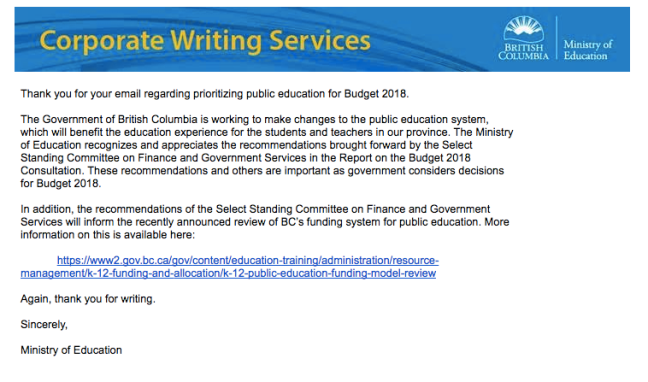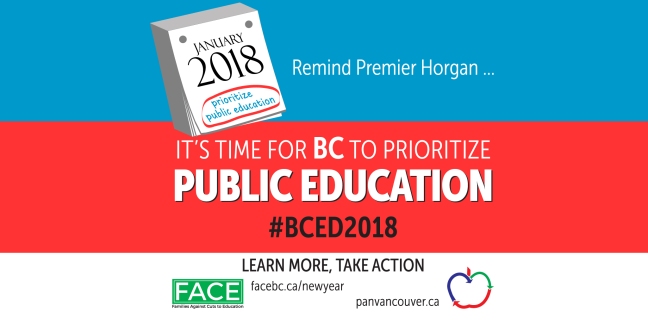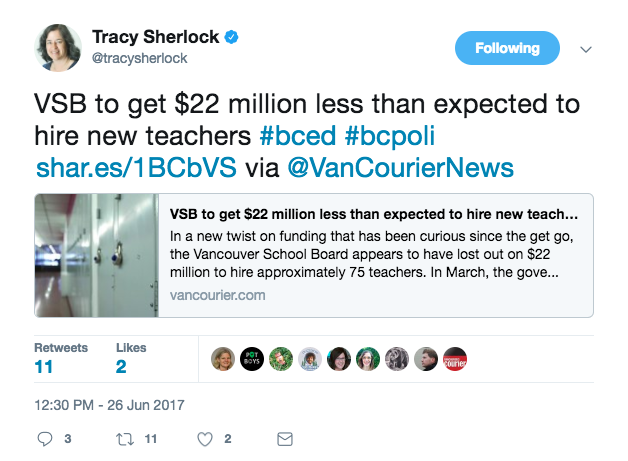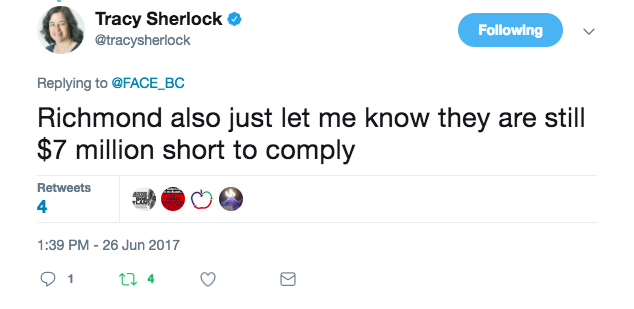The Select Standing Committee on Finance and Government Services is conducting consultations until October 16, 2017, prior to making recommendations to government on Budget 2018. Go to their consultation portal to fill in a survey or make a submission.
Below is FACE’s submission. You can also find it here in PDF form.
Who we are
Families Against Cuts to Education (FACE) is a non-partisan, inclusive group representing parents and other citizens who are concerned about public education funding levels in BC and want to see public education treated as an important investment in the future rather than an expense to be minimized. We advocate for public education as a social good that benefits not only BC’s children, but also BC’s society more broadly.
Endorsement of submissions by other groups
In addition to our submission below, we endorse and applaud the submissions made by the BC Confederation of Parent Advisory Councils (BCCPAC) and the Parent Advocacy Network for Public Education (PAN). In the interest of brevity, and to avoid repetition, we echo the points made in their submissions and urge you to implement their recommendations.
Public education in BC continues to be underfunded
FACE made submissions to this Committee in 2015 and in 2016; subsequently, in both of those years, the Committee made recommendations to increase public education funding. Unfortunately, the Committee’s recommendations with regard to public K-12 education were largely ignored in the 2016 and 2017 budgets, and it is necessary for us to repeat our call for increased funding.
In November 2016, the Supreme Court of Canada ruled in favour of the BC Teachers’ Federation (BCTF) in its case against the government of BC. This resulted in an agreement with the BCTF with regard to increased hiring of teachers to meet class size and composition requirements, and more money has been allocated to pay for this agreement with the BCTF. This increased funding was included in the September 2017 Budget Update. But funding outside of the BCTF agreement has remained stagnant; therefore, many issues of underfunding continue to exist and grow in public education.
Year after year, districts throughout the province have been required to make cuts in order to balance their budgets and make up for the shortfall between the actual costs of running a district and the amount allocated to them by the government. For example, in budget season 2016, we compiled a list of 31 districts that had a combined shortfall of $85.28 million. Examples of the types of cuts made—and often compounded year after year—were listed by the BC School Trustees’ Association (BCSTA) in 2015:
- Reduction or elimination of student bussing (once considered a core service)
- Implementation of monthly student transportation fees
- Increased class sizes and the loss of elective classes
- Reduced support services for students including fewer Education Assistant hours
- Reduced school supply budgets affecting the classroom directly
- Reduced support for teacher and school-based innovation projects
- Program, classroom and school closures
- Expanded introduction of a two-week spring break and fewer school days
- Reduced building and grounds maintenance, supplies and summer work
- Deferment or cancellation of technology upgrades and implementation
- Reduced library time and fewer library services for students
- Loss of co-curricular music and arts programs
- Reduced funding for students’ extracurricular programs such as sports
- Reduced custodial services for schools
- Reductions in school and district administration services
- Delayed replacement of text books and library books
- Higher costs for community groups wanting to use school facilities
Most of these cuts to programs and services relate to items outside the scope of the court case and therefore have not been alleviated by the increased funding related to the agreement with the BCTF. In other words, these cuts remain in force and will continue or worsen unless operational funding is increased to address these costs.
We will expand below on a couple of the items listed by the BCSTA, but want to emphasize that reversing all of these cuts is necessary in order to provide quality equitable public education to all of BC’s learners.
With regard to cuts to custodial services, a 2017 Canadian Union of Public Employees survey of custodial staff “found that 55.4% of staff don’t believe they’re able to maintain a clean and safe school.”
With regard to reduced building and grounds maintenance, the cost of accumulated deferred maintenance across the province has been estimated at $5 billion. Health issues such as lead and asbestos in schools have not been properly addressed, and many buildings have been allowed to decay into decrepitude. Our children spend their days in these buildings; they deserve better.
One way to address the outstanding deferred maintenance is to build new replacement schools as part of the Seismic Mitigation Program. New schools are designed to be usable immediately after a quake (unlike retrofitted buildings, which are only designed to allow exit during the quake), and building new addresses issues such as asbestos, lead, leaky roofs, ancient boilers, and inefficient windows, that would not be covered by seismic retrofitting.
The new provincial government has promised to speed up the Seismic Mitigation Program and to build new schools in areas where demand has increased (such as Surrey, Chilliwack, and parts of Vancouver, to name a few). Unfortunately, this promise was not matched with increased capital funding for the 2017/18 year in the September 2017 Budget Update. Capital funding for safe replacement schools and necessary new schools is crucial to ensure the safety of the thousands of children and adults who spend their days in BC’s public schools, and to ensure that community hubs exist and children do not spend their school years in portables.
The current funding model is not working
Persistent underfunding of the public education system is the root cause of the issues discussed above. Furthermore, the per-pupil model of funding implemented in 2002 is innately unpredictable and makes it very difficult for districts to make long-term plans. In addition, the provincial government has a history of dictating what funding will be given to the districts, without consulting the districts as to what their costs are, and leaving them to scramble to address shortfalls. We reiterate our call for a commission to review the funding model with the aim of moving to a model that includes cooperation and consultation with districts in order to provide funding that is predictable, stable, and sufficient to provide quality equitable public education to BC’s children.
Summary
We urge the Committee to recommend that the government
- increase operational funding to reflect the actual costs of providing quality equitable public education;
- increase capital funding to address deferred maintenance, speed up the Seismic Mitigation Program, and build needed new schools; and
- appoint a commission to find a cooperative funding model that ensures stable, predictable, and adequate funding.







You must be logged in to post a comment.